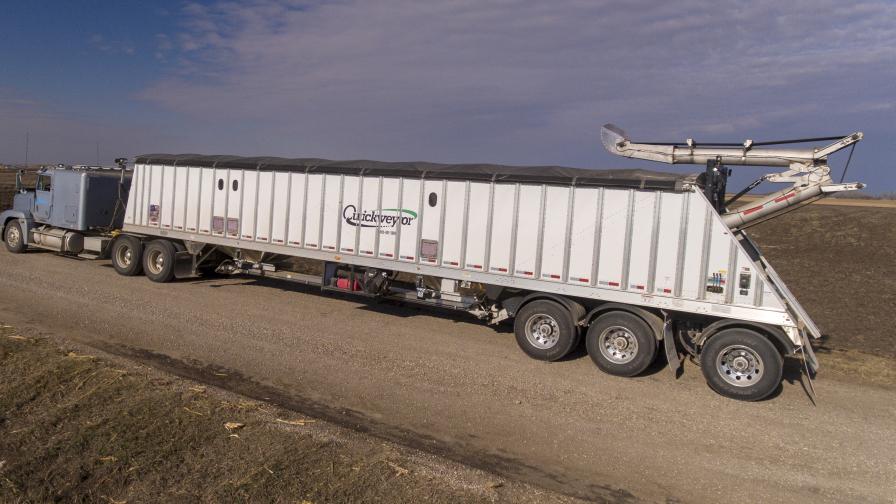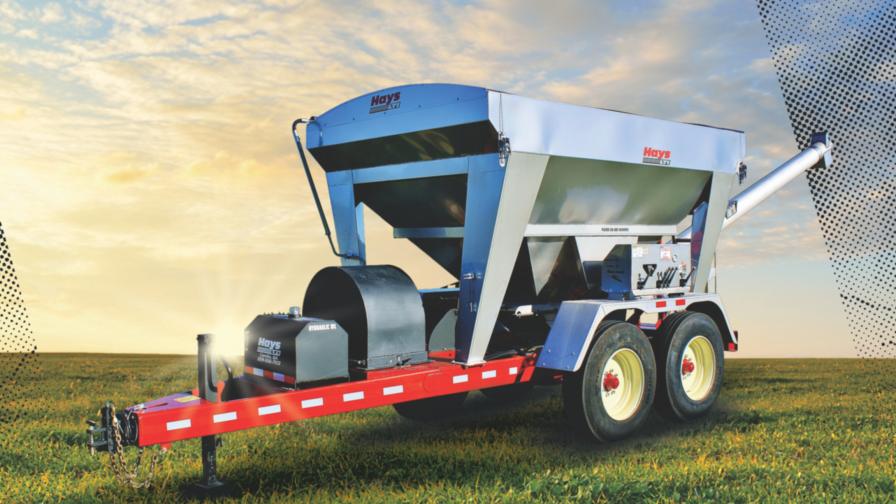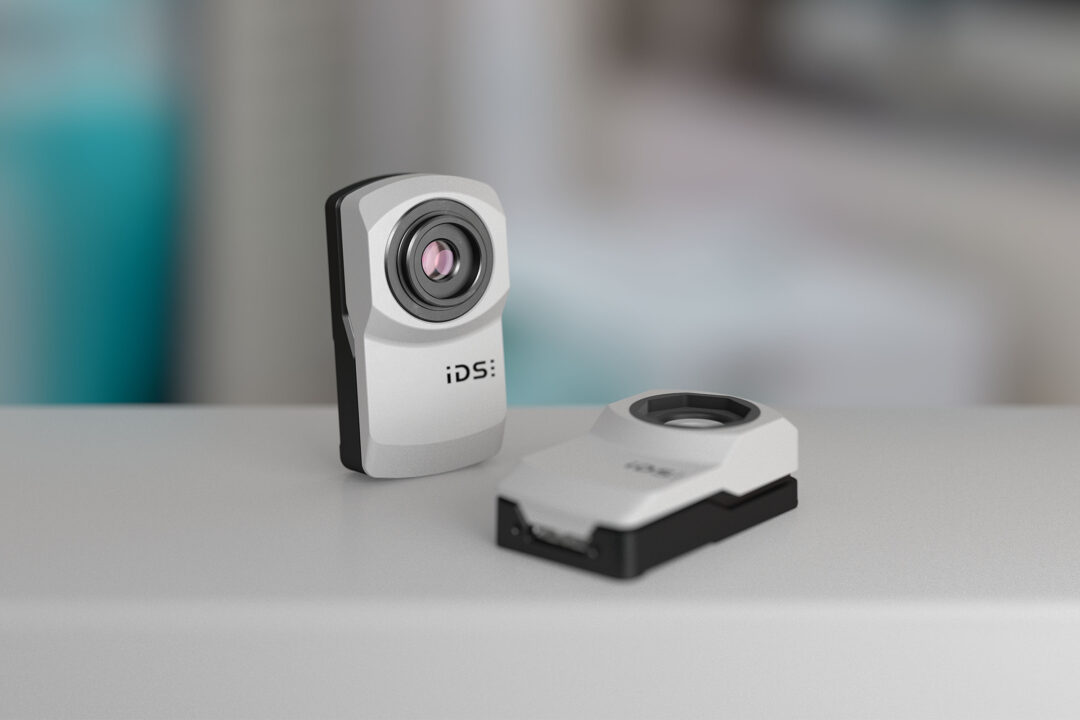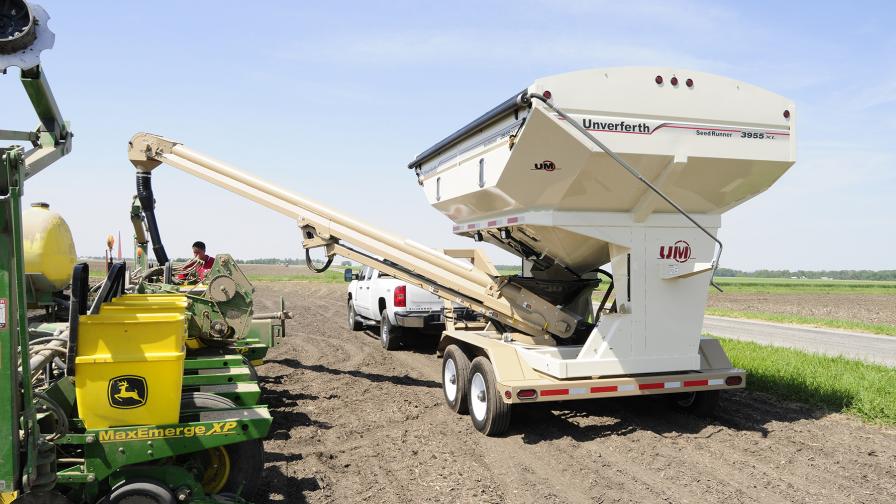Fertilizer and Seed Tenders: Safety, Value Among Top Priorities for Manufacturers

The Quickveyor 50-foot triaxle tender offers 32 tons of capacity.
Safety remains a concern to the manufacturers of fertilizer and seed tenders, to the point in which at least three companies believe it is the most pressing issue specific to the machines.
“Operator safety has been the most prominent issue concerning tenders for the past few years,” David Juette, Production Manager with Doyle Equipment Manufacturing in Palmyra, MO, says.

Sales of Hays LTI tenders were “far above expectations” in 2018 and leading into 2019, the company says.
Hays LTI takes the issue seriously from its headquarters in Camilla, GA, according to General Manager Matt Hays. “As a manufacturer, it is our responsibility to provide the safest piece of equipment possible to our customers. We understand the liability this industry faces when using fertilizer equipment, which is why safety and ease of operation continue to be top priorities for us,” Hays says.
At Simonsen Industries in Quimby, IA, two issues share top billing. The first is value. “Our customers want to feel that they are getting their money’s worth from the equipment that they are purchasing,” President Jon Simonsen says. The second issue is the safety of the company’s drivers and customers. “There are several features that customers are requesting to help make the use of their equipment safe and easy to use for their drivers,” Simonsen says.
How are companies improving the situation?
“Doyle Equipment has significantly improved operator safety with tenders by developing ways of keeping employees off ladders and out of the tenders,” Juette says. “Steeper slopes on the hoppers allow tenders to clean out better, and with the available options, such as vibrators, inspection windows, and electric tarps, this has become more achievable.”
Hays LTI provides proper safety decals and warning labels and an owner/operator manual with safety instructions. “We manufacture our Hays tender to be simple and easy to operate. Stainless steel hopper grates, hose and valve covers are standard on all of our tenders,” Hays says. “We position our valve bank to give the operator a clear line of sight of the discharge auger unloading material.”
Safety aside, Tim Tenhet, National Sales and Marketing Manager with The KBH Corp. in Clarksdale, MS, agrees with Simonsen in that value cannot be underestimated.
“Fertilizer dealers are increasingly looking for the best return on their equipment investment, which means overall reliable performance and durability,” Tenhet says. “With rising steel prices due to tariffs and other variables, equipment prices have been on the rise. With a somewhat sluggish ag economy, dealers are more conscious of their margins than ever, and getting the most out of their equipment investment is more important than ever.”
At Unverferth Manufacturing in Kalida, OH, employees are bent on meeting the agriculture industry’s longing for “bigger, faster, better,” Marketing Manager Andy Unverferth says.
“As farm operations continue to grow, there is a growing need to be more efficient and get the seed in the ground faster during the busy planting season. While we want to increase speed, we also want to be cognizant of the fact that we do not want to damage the seed during transfer,” Unverferth says.
Peterson Motors/Quickveyor has been focusing on the “bigger” aspect of tenders. “In the past few years our customers have communicated interest in increasing the legal capacity and speed of delivery for their fertilizer and seed tenders,” Tim Peterson, the company’s Product Communication Liaison, says. “Everyone is looking to gain efficiencies, and increasing capacity is the major avenue to achieve this.”
The Watertown, SD, firm responded with the release of its “biggest innovation yet,” according to Peterson. The Quickveyor 50-foot triaxle tender offers 32 tons of capacity and greatly increases payload when roads are load-limited in the spring, he adds. “Our customers have also noted that the QV50 is a simple and reliable design that has an even higher rate of delivery than the market-leading Quickveyor, at well over 6,000 pounds per minute.”
Larger capacities and lower empty weights are some of the changes that Hays expects to see in 2019. “We are continuously incorporating customer feedback into our design, so these two things have been and will continue to be key features of our Hays tender,” he says.
New Year, New Game Plans
Beginning in 2019 manufacturers who supply diesel engines on their self-contained tender units will have to meet EPA emission regulations for Tier 4 engines.
“With this you will see increased pricing on these style tenders that all equipment manufacturers will be challenged with,” Juette says.
Hays LTI has been preparing for the change. “Making the transition to Tier 4 engines will be a challenge to ag retailers, growers, and tender manufacturers in 2019,” Matt Hays says. “Our company started installing Tier 4 engines in 2017, and we now have more than a year’s experience and several hundred units in service. Even though this engine will require more care and maintenance, we’re seeing many advantages over the older-style engines.”
In other developments, corporate mergers are affecting tender manufacturers. “As many major ag retailers merge, we have seen that they are requiring consistency across their locations,” Peterson says. “Utilizing the same tender for both seed and fertilizer makes sense, with off-season hauling being an added bonus.”
Meanwhile, competition among manufacturers, Tenhet says, has “served the industry well.” Prices have remained mostly flat on tenders, with more features than ever before, he says. But costs have risen, he adds, and “at some point manufacturers will have to make some price adjustments.”
Hays cites service as being one of the key components that buyers should consider before purchasing a large piece of equipment like a tender. “Keeping your tender clean, greased, regularly serviced, and inspected will help prolong the life of your equipment,” he says.
Simonsen’s best customer advice: “Do the math when it comes time to pick a tender. One or two extra loads per day can make a big difference to your bottom line.”
Company News
Doyle Equipment Manufacturing: A new facility now affords the company the manufacturing capability to offer its customers equipment with much shorter lead times, Juette says. “If spring season demands more fertilizer tending power for retailers, Doyle will be ready to meet those demands,” he adds. Doyle Equipment offers a range of sizes and style of tenders, from 8- to 32-ton capacity. The rear, side or overhead discharge style tenders all offer long enough augers to fill the tallest applicators on the market, Juette says. The company also offers a fleet of rental trailer tenders that will expand in 2019. Those trailers are available in side or rear discharge.
Hays LTI: Tender sales were “far above expectations” throughout 2018 and leading into 2019, Hays says. “After moving into our new plant and adding a line of smaller pull-type tenders, we have been able to increase production and meet the needs of more customers,” he says. “We are expecting 2019 to be our biggest year yet.”
KBH: The company made wholesale changes to its Dry Tender line, from the trailer up, Tenhet says. “So, we have a great track record of hundreds of new model units that are performing — lighter trailer weights, less mild steel, increased hopper capacities, more user- and maintenance-friendly features.”
Peterson Motors/Quickveyor: The Quickveyor team has been improving its system for almost 20 years, Peterson says. “(Our) focus has always been on improving reliability while increasing capabilities to support our customers’ feedback and needs through a robust customer relationship culture that we are proud to maintain.”
Simonsen Industries: The company has redesigned and added features to its line of rear, side, and top auger tenders to increase ease of use, ease of maintenance, and promote the safe operation of its equipment, Simonsen says. “Changes for 2019 will focus on user ease,” he adds.
Strobel Manufacturing: The company’s No. 1 innovation, according to Marketing Director Larry Myers, is its replaceable one-piece rubber gaskets on box tenders. They can be added to any Strobel seed tender, he says.
Unverferth: The 2017 launch of the Seed Runner 55-Series with its patented conveyor design was followed last year by a new series of Seed Pro bulk box carriers with the new conveyor. Also new in 2018 was the bulk box carrier 10-Series Seed Pro, with the conveyor design. “Always consider the conveyor design when looking at seed tenders,” Unverferth says. “Every year there is a large investment in seed, and we want to get it in the ground as fast as possible, but what good is it if it’s damaged?”








